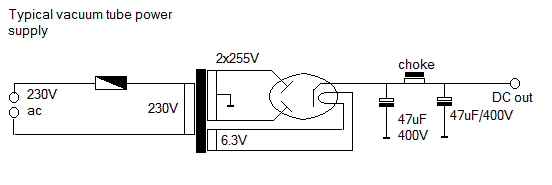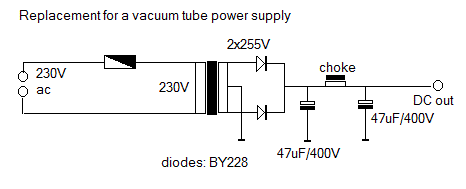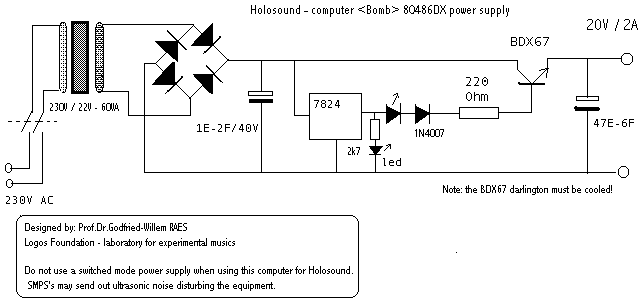Power Supplies
No matter what kind of electronic device, unless powered from batteries, it invariably will have a power supply. The vast majority off all circuits used in audio internally work on DC voltages. Today these power supply components have long become commodity items that you just buy off the shelves, but in equipment build before the mid seventies more often than not, you will encounter discrete circuitry. When servicing legacy equipment, the very first thing to be checked always will be the power supply. Very often, if found defective, it will also be the last thing to do to get the repair done. Hence, this little chapter on power supply issues despite the fact that this topic might appear to be irrelevant for the performance practice of music using legacy equipment.
Long before semiconductors and vacuum tubes came into common use, stabilized power supplies did already exist. Here is a description, for those interested in what could be called the prehistory of electronics.
Power supplies in vacuum tube equipment in general look like this:
Sometimes you will find rectifier tubes labeled GZ34, working with a filament voltage of 5V, but most commonly 6.3V filaments were used. Typical vacuum tubes have been EZ41, EZ9x, EYx etc... The first character of the type number -at least for European vacuum tubes- gives the filament voltage: A= 4V, G = 5V, E=6.3V, D=1.5V. It's not a good idea to keep the original tubes nor to replace them. Nothing will go wrong if you replace them with the alternative semiconductor circuit given below:
If you have an old plug, fitting in the vacuum tube socket, the diodes can be soldered on the plug, replacing the tube. If no plug is available, you might consider to use the vacuum tube base itself as such, in which case you need to break the tube and remove it fully from the socket. The filament wires remain unconnected, unless in the rare cases you have to do with directly heated cathodes. In that case, connect one of the filament/cathode wires and leave the other one unconnected. Obviously, high voltage diodes are to be used. Check the electrolytic capacitors, as very often they will be leaky. They can even explode if the equipment has not been used for a very long time... In many implementations, the choke will be replaced with a simple power resistor (in the 100 Ohm range). If the equipment suffers from hum, the value of the electrolytic capacitors can be raised. However, never do this if you want to leave the vacuum diodes in place as the tubes cannot withstand the current surge with larger capacitance values. If, after the replacement, you find the output voltage to be somewhat higher than it ought to be, this is due to the smaller voltage drop in semiconductor diodes. You can lower the voltage a bit by inserting a small series resistor or -if possible- by playing around with the tabs on the transformer. Most of the time, a slightly higher voltage does not have adverse effects on the functioning of the device. In vacuum tube equipment very often double or even triple electrolytic capacitors were used. Nowadays these type are obsolete and no longer in production. They are in fact nothing but two or three capacitors (generally between 33 uF and 68 uF in value) in a single aluminum can with a shared negative electrode. They can be replaced with two or three separate capacitors. Generally, there is enough place for the replacement as modern types tend to be quite a bit smaller.In general, voltage stabilization was rarely used. If you run into a circuit with vacuum tube stabilization (commonly using a gas filled tube), you should consider replacing it as well with a semiconductor alternative. Stabilizer vacuum tubes have become impossible to find now taking into account that they have become completely obsolete. Linear high voltage regulators can be found on the market and can easily replace them. Often Zener diodes of appropriate specifications can come to rescue here.
Power supplies in discrete analog semiconductor equipment:
Before the advent of linear stabilizer IC's, power supplies were build from discrete components. Some of them even with great circuit complexity. If in such circuitry a non obvious fault is detected, attempts to repair should be limited to checking the large pass transistor, mounted on a heatsink. Only if this transistor is found to be defective and only if it's a silicon type, you can replace it and see whether it works again. If this fails, don't loose time but rather design a new power supply using linear regulators. These exist with fixed output voltages such as 3.3V, 5V, 6V, 8V, 9V, 10V, 12V, 15V, 18V, 24V as well as with adjustable output voltages up to 80V. Output current is generally limited to 1 or 1.5A (for common voltages such as 5V and 12V 10A types do exist), but if you need higher currents, these regulators can be paralleled. Don't forget cooling!
Analog equipment using chips instead of discrete transistors almost always make use of an integrated analog regulator in the power supply. If found defective, search for a possible cause. To do this a lab power supply is required. It allows you to monitor current and voltage at the same time. If no cause is found, it could have been caused by external equipment, wrongly connected to the device. Replace the linear regulator and check the capacitor.
Note that transistorized equipment from the sixties and early seventies may make use of germanium transistors. Most often such circuits have the positive power supply pole at ground level! If this is found to be the case, replace with a negative power supply circuit.
Here are some circuits, with adjustable output voltage, that can be used as replacements in all cases where the current exceeds 1 Amp. If less is required, just use a single linear regulator.:
Or, using an expensive 10A linear regulator:
In analog audio equipment, dual power supplies are the standard. Most operational amplifiers work best with dual supplies. Common voltages are +15V / -15V. Precision circuits, such as found in synthesizers, sensor interfacing circuitry and analog computers require tracking dual power supplies. In these, the absolute value of the positive and negative output voltages are kept equal in absolute magnitude within 0.1% or much better. Here is a well tested high performance circuit example:
This circuit differs from most textbook circuits and designs in that it lets the negative voltage track the positive one. This design was developed by us based on the practical experience that in general the positive side tends to get more load then the negative one. Loads are rarely balanced in practical circuitry.
In audio power amplifiers these dual voltages can be much higher. The voltage is directly proportional to the output power of the amplifier and stabilization of this voltage is normally not applied, exception made for the preamp sections. If these amplifiers fail it's quite pointless to repair them. Unless the repair is limited to replacing a fuse, just get a new amp and save your time for something more creative or artistic... A good amplifier is a good amplifier and can easily be replaced without any effect on the audio. A bad amplifier -some types are popular in pop music- isn't worth being repaired.Never exchange a power supply in analog equipment with a switched mode power supply module. Doing so causes audio interference as well as malfunctions on the analog inputs, not being designed to cope with high frequency ripple on the supply lines.
Power supplies in early digital equipment.
From the early days on, almost all digital equipment is powered with an SMPS (Switched mode power supply). For the earliest devices, build up using discrete components. If these fail, do not attempt to repair them. Replace with a suitable off the shelf unit within the specs.
Sometimes it is a good idea to even replace an SMPS power supply with a linear stabilized alternative. The latter will certainly turn out to be much more bulky and expensive, but the advantages in audio performance of the equipment can be tremendous. In numerous cases, we saved musicians concerts by replacing their laptop power supply with a linear one. For the first generations of Apple laptop computers, this was a very common problem and the owners could only produce decent audio from their laptop when fed from their internal batteries... as long as they last.
Here is an example for a replacement for an old laptop power supply requiring 20V at 2A:
Lab power supplies:
The most common types offer single or dual voltage outputs ranging from 0 to 30V and can deliver currents up to 3 Amps. For most repair work they perform quite O.K. However if you have to service vacuum tube circuitry, the voltage range will be way too low. Confronted with this problem, and also because of our needs in musical robotics, we designed a high voltage variable bench power supply ourselves. Here are the details. Next to this, a large rotary transformer (a variac) is an invaluable tool for powering vacuum tube equipment that has not been switched on for a long time.
The procedure consists of setting the transformer to about half the normal operating voltage, switching the device on and over a timespan of an hour or more, gradually bring up the voltage whilst monitoring what happens in the circuitry in the meanwhile. This procedure helps the capacitors self-healing a bit, although one shouldn't count on it. They may just as well cause a short or explode...
A noted of warning here: Variable voltage transformers are so called 'autotransformers'. They have no split primary and secondary windings, hence they do not isolate the user from the main power lines. This is an inherently unsafe situation and the only way to remedy this health hazard is to feed the variac from a real safety transformer, thus floating its output voltage.
Hum
The main reason why we pay so much attention to power supplies here, is the simple fact the one of the most common nuisances in early electronic music (live as well as in studios) was the phenomenon of hum. In Europe, 50 Hz and in the US 60 Hz. Searching for the source(s) of hum plagued almost all lineups and suppered up many hours of investigations. This nasty noise was extremely hard to get rid of. It had three quite distinct causes: the power supplies of the equipment used, ground loops, and mains voltage induced noise from low voltage, high impedance lines and transducers. Power supply caused hum is what we treated here together with some possible suggestions for solutions. One important solution- we left out here -because it is not generally thought of as being part of the equipment- is that power supply caused noise can be completely canceled, by using batteries as power sources. Of course, this is not suitable for vacuum tube equipment. For transistorized gear, very often in live electronic performances, batteries or even car batteries have been used. The British composer/performer Hugh Davies, almost always was feeding his equipment from batteries for that reason. Ground loop noise is very hard to find a simple remedy for. Our own solution has always been to use a separation transformer to feed all equipment in the setup, such that it can work 'floating', that is, free from any connection to mains ground. The last source however, can only be eliminated by using balanced lines, lowering impedance's and avoiding inductive pickups. The latter is often just impossible: tape heads are inductance's just as well as electric guitar pickups and many common types of microphones.
In top-quality audio equipment using vacuum tubes, often one will find that the filaments of the vacuum tubes are being powered with pure DC instead of the standard 6.3 V ac. This was done as yet another attempt to minimize hum in the audio signals.
Bibliography and references:
De Muiderkring B.V., 'Electronic Tube Handbook', 19th edition, Bussum, 1981.
Jansen, J.H., 'Transistoren, theorie en praktijk', Kluwer N.V., Deventer, 1964
Schultz, Reinhard 'Netzgeraete', M.Frech Verlag, Stuttgart-Botnang, 1969
This article is part of a research project on Experimental Legacy financed in part by the Orpheus Institute in Ghent.
www.orpheusinstituut.be






